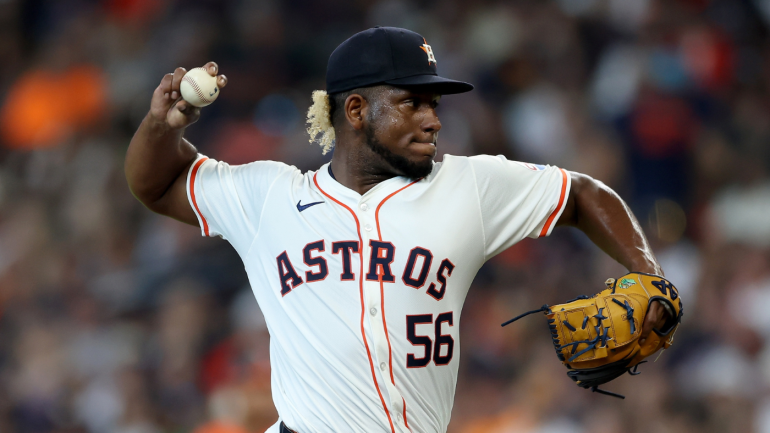
Houston Astros righty Ronel Blanco will attempt to continue his surprisingly effective year tonight against the New York Mets. He will enter the contest with marks that include a 2.34 ERA (169 ERA+) and a 2.32 strikeout-to-walk ratio across 14 appearances. He's held opponents to one run or fewer in each of his last three starts, including his most recent appearance versus the Baltimore Orioles.
Blanco, 30, wasn't supposed to serve as the Astros' de facto ace. Truthfully, if the Astros had their druthers, he wouldn't have been part of the rotation at all. Instead, Blanco received the opportunity when it became evident Justin Verlander would miss the start of the season. Blanco took full advantage of the chance, throwing a no-hitter versus the Toronto Blue Jays in his first time out and not yet relenting in the time since. Now, he's positioned himself to make the All-Star Game.
Should that come to fruition, it'll represent a remarkable turnaround for Blanco, who came into this season sporting a 4.78 ERA (89 ERA+) in his first 24 big-league appearances in his first two seasons. Just how has he transformed from an overlookable depth piece to a rotation anchor?
Here are three factors that help explain Blanco's ascent.
1. Deeper arsenal
Prior to this season, it was fair to describe Blanco as a two-pitch pitcher. Across his 17 MLB appearances last year (including seven starts), he threw his fastball or his slider nearly 90% of the time. To date this season, those pitches have a combined usage rate under 70%.
Blanco has used most of that 20% to prioritize his changeup, upping its usage from 9% to 26.5%. (He's also thrown a greater share of curveballs.) While a lot of pitchers will deploy their cambio only when faced with a platoon disadvantage, that's not the case here. Blanco has thrown nearly 40% of his changeups when opposed by a right-handed batter. All of that would be window dressing if the results on the pitch were poor. Predictably, Blanco has found great success with his changeup: its .148 average against and 35.7% whiff rate are both the best in his arsenal.
Ronel Blanco, Dirty 86mph Changeup. 👌 pic.twitter.com/K3ATLVKBMy
— Rob Friedman (@PitchingNinja) June 16, 2024
Blanco's changeup also grades as his best pitch through the lens of pitch-quality models that incorporate velocity, movement shapes, and the like. Baseball Prospectus' StuffPro metric, for example, has Blanco's changeup as the 19th best among starters. That may not sound like a big deal, but think about it this way. Take a pitcher, any pitcher, and add a pitch to their arsenal that's good enough to rank in the top 20 of the league. Think that'll improve their trajectory?
Bear in mind, there's an interplay aspect to consider whenever a pitcher alters their repertoire. It's not just that batters have to account for Blanco's changeup, it's that they have to do that on top of dealing with his fastball and slider. Their chances of correctly locking in on a pitch type or pitch location are now reduced, giving Blanco a greater advantage than he previously possessed.
Speaking of which ….
2. Deceptive fastball
We're not going to write that this development is entirely because of Blanco's changeup, but it's hard to ignore that factor when you look at how much better his fastball has performed this season. In 2023, opponents hit .343 against the heater with a 95.6 mph average exit velocity and an 18.5% whiff rate; in 2024, those marks are .167, 91.7 mph, and 22.1%. That's a hat trick of bettering.
Ronel Blanco, 94mph Fastball & 86mph Changeup, Individual Pitches + Overlay pic.twitter.com/egmou1JJIJ
— Rob Friedman (@PitchingNinja) April 2, 2024
Blanco's fastball, by the way, is interesting in its own right. It doesn't grade well on the pitch models, but it does feature more rising action than is typically associated with his release point. Indeed, Blanco's heater offers nearly 18 inches of induced vertical break, as opposed to 16.6 inches for pitchers who are within an inch either way of his 73.1 inch release height. (He also gets further down the mound than those pitchers do on average, causing his fastball to play up a touch.) In some respects, it's fair to think of Blanco as being a bit like teammate Cristian Javier, where their release point and innate verticality help them live up in the zone despite so-so velocity.
There's one other dynamic at play that could be responsible for enhancing Blanco's fastball.
3. Improved location
Perhaps this is self evident, but Blanco has showcased some control gains. Whereas he had walked 12.4% of MLB batters he had faced entering this season, he's sporting a 10.2% walk rate to date. Now, we're not going to pretend that Blanco has developed Madduxian control; he still has one of the highest walk rates among starters in the game. Yet there is a difference between leading the majors in free passes (as he would've with his old percentage) and merely being in the bottom five.
Besides, Blanco has some other positive command indicators working in his favor. His overall percentage of pitches that have gone for a strike (64.5%) is better than the league-average mark (64.1%). He's also improved in more granular measures. TruMedia houses a statistic called "competitive location percentage" that tracks how often a pitcher's offerings are placed within 18 inches of the middle of the strike zone. Take a look at how Blanco has fared over the years:
| Season | Competitive Location% |
|---|---|
2022 | 78.2% |
2023 | 80.2% |
2024 | 84.0% |
We're not pretending that quantifying command is as simple as asking "was it within 18 inches of the middle of the strike zone?" We are, however, willing to look at all the supporting evidence and assert that Blanco has improved his location. That, plus the combined effects of his more varied arsenal, have clearly allowed him to level up -- from someone who wasn't assured a roster spot in the spring, to someone who must now be considered an essential part of an Astros playoff run.


















